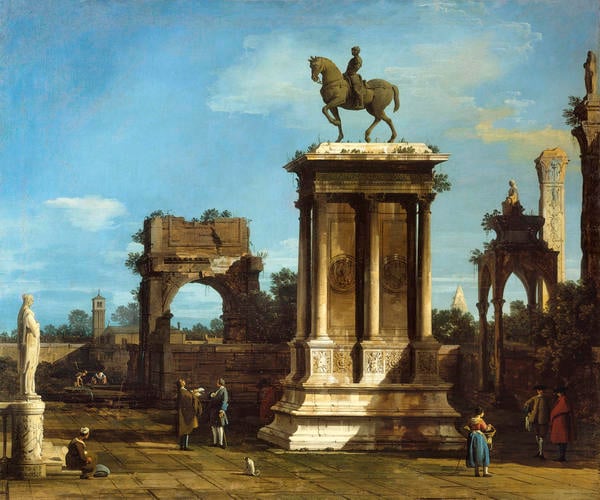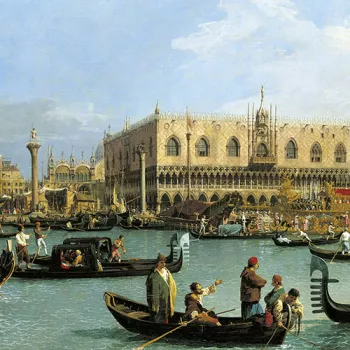The Colleoni Monument in a Capriccio Setting Signed and dated 1744
Oil on canvas | 108.3 x 130.2 cm (support, canvas/panel/stretcher external) | RCIN 404415
-
Andrea Verrocchio's famous bronze sculpture of the fifteenth-century mercenary general Bartolomeo Colleoni (1395–1475) stands on a high pedestal in the Campo Santi Giovanni e Paolo (see RCIN 400715). Rather than a static, idealised portrait, Verrocchio has made the statue of rider and horse appear to be driving forward. One of the horse's forelegs is raised as if in movement, its head turned to the left, while Colleoni also pushes his left side forward. Canaletto's depiction of the statue is more passive, stately and classical: he has raised the plinth even higher so that the smaller size of the sculpture and the fact that it is parallel to the picture plane minimises its dynamic movement. The sculpture is made to appear like an ancient monument similar to those that surround it, with vegetation and the passage of time suggesting that Colleoni belongs to a great era that has now passed.
To the left of the Colleoni monument is an arch similar to the Arch of Titus. On the far left is a large statue of a woman, possibly the Virgin Mary, on a round pedestal bearing Canaletto's signature. Behind Colleoni is an arched canopy with a statue of a seated woman, reminiscent of the five Gothic tombs for the Scaliger family, who ruled in Verona from the thirteenth to the late fourteenth century. There is also a huge version of one of the Pilastri d'Acri, the sixth-century pillars then thought to be from Acre, which stand on the south side of San Marco (see RCIN 401037). At the extreme right is a similar pilaster with a statue. Beyond is a pyramid resembling the Pyramid of Cestius, built outside Rome around 18–12 BC as a tomb for Gaius Cestius.
The campanile in the distance, also seen in RCIN 405268, is similar to the lost campanile of Santi Biagio e Cataldo on the Giudecca. It has also been likened to the campanile of Santa Maria Assunta on Torcello, the site of Venice's earliest settlement. This link, and ubiquitous greenery, has prompted the idea that Canaletto's setting is Torcello or another island in the Lagoon and that the monuments represent different historical epochs, referring to Venice's past glories. However, not all are Venetian: the arch and pyramid seem to represent Rome. It is more likely, therefore, that the painting is a contemplation of the passage of time and the loss of a great past, suggested by the deep shadows from the slanting sun.
There is a close relationship between this overdoor and some of Canaletto's etchings from this period: the arched canopy, the Pillars of Acre, the figures gathered around the fountain basin and the tall statue of the woman all occur in The bishop's tomb (RCIN 807801–3), and the tomb and triumphal arch are in the Portico with the lantern (RCIN 807797). In both the etchings and the painting, daily life continues: the contemporary world seems unaware of the great achievements of the past, except perhaps for the man making notes or a drawing as he gazes up at the Colleoni statue.
This painting is one of a series of thirteen overdoors by Canaletto, all with the same provenance. Of the thirteen pictures, nine survive in the Royal Collection.
Signed on the base of the statue, far left; ANTO. C. F. / MDCCXLIV.
Text adapted from Canaletto & the Art of Venice, 2017.Provenance
Acquired by George III from the collection of Consul Smith in 1762 (Italian List no 97); recorded in the King's Closet at Buckingham Palace in 1819 (no 723)
-
Medium and techniques
Oil on canvas
Measurements
108.3 x 130.2 cm (support, canvas/panel/stretcher external)
129.4 x 152.9 x 13.2 cm (frame, external)
Category
Object type(s)
Other number(s)
Alternative title(s)
The Colleoni Monument in a Caprice Setting









